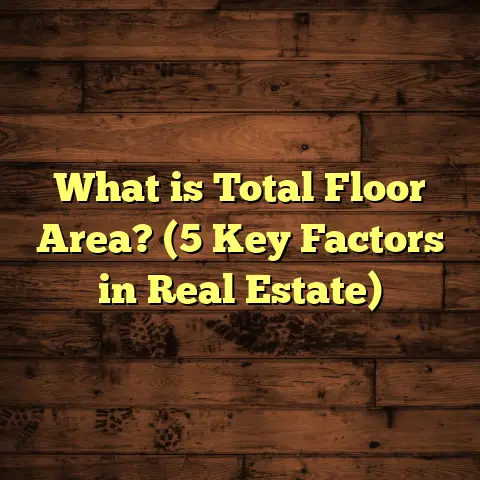What is Radiant Floor Heat Installation Cost? (5 Key Factors!)
I learned something fascinating some years ago that changed how I look at home heating forever: radiant floor
heating can improve energy efficiency by about 30% compared to traditional forced-air systems. When I first
heard that, I was skeptical—how could heating the floor be that much better? But after installing dozens of
systems myself and seeing the results, I became a believer. If you’re someone who has ever felt the cold bite
of chilly floors in winter or been frustrated by uneven heating in your home, radiant floor heat might be the
game-changer you need.
This isn’t just a luxury for fancy homes. It’s a practical, efficient way to heat your living space that has been
growing in popularity across the country. But if you’re considering it, there’s one big question you probably
have right now: how much is this going to cost me?
I’ve worked on both small bathroom radiant heating upgrades and full-house installations, and I’ve gathered a
lot of insights about what drives the price up or down. In this article, I want to share everything I know about
radiant floor heat installation cost, broken down into five key factors. Along the way, I’ll share stories from
my own projects and give you real data points to help you make a smart decision.
What Is Radiant Floor Heat Installation?
Radiant floor heating is a method of warming your home that uses heat radiated from the floor surface upward,
rather than blowing warm air through vents. The idea is pretty simple but brilliant: instead of heating the air,
you heat the objects and people in the room directly. This creates a more consistent and comfortable warmth.
There are two main types of radiant floor heating systems:
- Electric radiant floor heating: This system uses thin electrical wires or mats installed beneath the floor.
When electricity flows through these wires, they generate heat that warms the floor. - Hydronic radiant floor heating: This system circulates warm water through flexible tubing embedded under
the floor. The water is heated by a boiler or water heater and carries warmth evenly across the area.
Each has its own pros and cons when it comes to installation cost, energy efficiency, and ideal use cases.
The installation process involves embedding these heating elements under your flooring material—whether that’s tile,
wood, laminate, or even carpet. The system then connects to a thermostat so you can control the temperature easily.
I remember one first-time client who was blown away by how quiet and invisible the system was compared to their noisy old baseboard heaters. They called it “heating magic” because you don’t see or hear anything, but you feel the warmth everywhere.
Why Choose Radiant Floor Heating?
You might be wondering why anyone would spend extra money on radiant floor heat when they already have a furnace or heat pump. Well, here’s what I’ve learned from both installing these systems and talking with homeowners:
- Comfort: Radiant floor heat eliminates cold spots and drafts. Walking barefoot on a warm floor feels amazing in winter.
- Energy Efficiency: Because heat rises naturally from the floor, less energy is wasted warming unused air near ceilings.
- Silent Operation: No noisy fans or blowers; just steady warmth.
- Better Air Quality: Without forced air circulation, there’s less dust and allergens moving around.
- Design Freedom: No bulky radiators or vents limit furniture placement or interior design.
- Durability: These systems often last 25 years or more with minimal maintenance.
But of course, all those benefits come with a price tag—so let’s get into what affects that price.
1. The Type of Radiant Heating System You Choose
The biggest factor influencing cost is whether you pick an electric or hydronic system.
Electric Radiant Floor Heating
Electric systems are generally less expensive upfront because they have fewer parts and simpler installation.
They use thin cables or mats directly under the flooring that plug into your electrical system.
- Cost Range: Usually between $8 and $15 per square foot installed.
- Best For: Small areas like bathrooms, kitchens, or spot heating zones.
- Pros: Simple installation, quick response time to thermostat changes.
- Cons: Higher operating costs for larger areas due to electricity prices.
I installed an electric system in a small guest bathroom last winter for about $1,200 total. It took just a day to install, and my client was thrilled how warm the tile floor felt during cold mornings.
Hydronic Radiant Floor Heating
Hydronic systems are more complex because they require plumbing tubing, pumps, a water heater or boiler, and control valves.
- Cost Range: Around $10 to $20 per square foot installed.
- Best For: Whole-house heating or large spaces.
- Pros: More energy-efficient long-term, lower operating costs with gas boilers or solar water heaters.
- Cons: Higher upfront price, longer installation time.
One job that sticks out was a large family home where I installed hydronic radiant heat throughout their 2,000 square foot living space. The installation took several days and cost about $30,000 but cut their annual heating bills by nearly $1,200 after just one year.
Which One Should You Pick?
Ask yourself these questions:
- How big is the area you want to heat?
- Is this a new build or retrofit?
- What is your local energy cost (electricity vs gas)?
- How quickly do you want the floor to heat up?
Electric systems are great for small-scale applications and retrofits with limited budgets. Hydronic systems make more sense for whole-house heating with better long-term savings potential.
2. Flooring Material Compatibility and Cost Impact
Have you noticed how some floors feel warmer underfoot than others? That’s partly because different materials conduct heat differently—something I always consider during installations.
Tile and Stone Floors
Tile and stone are excellent at conducting heat because they have high thermal conductivity. They absorb warmth quickly and radiate it back efficiently.
- Installation Tip: You usually need an additional thin layer of cement board or underlayment to protect heating elements.
- Cost Impact: Tile itself can vary widely; porcelain tile costs around $5-$10 per square foot on average, not including installation.
- Experience Insight: Tile plus radiant heat creates a spa-like feel in bathrooms or kitchens — a combination many clients love.
Engineered Hardwood
Engineered hardwood works well with radiant heat because it is more dimensionally stable than solid wood. It won’t expand or contract as much with temperature changes.
- Installation Tip: Always check with your flooring supplier to confirm compatibility.
- Cost Impact: Engineered hardwood flooring generally costs between $6-$12 per square foot installed.
- My Story: I installed radiant heat under engineered oak flooring in a living room once. The homeowner said it felt like walking on sunshine during winter—pure comfort.
Solid Hardwood
Solid wood flooring poses some challenges because it expands and contracts with humidity and temperature changes. Improper installation over radiant heat could lead to warping or gaps.
- Cost Impact: Solid hardwood costs more than engineered varieties, often upwards of $10-$15 per square foot installed.
- Note: Some species like maple or cherry are better suited for radiant heat than others.
Carpet and Vinyl
Carpet doesn’t conduct heat well unless it’s very thin; thick carpet insulates away warmth which reduces system efficiency.
Vinyl flooring works fine but not all products are rated for underfloor heating; check manufacturer specs carefully.
3. Size and Layout of Space
How big is the space you want to install radiant floor heat in? This straightforward factor impacts your overall price in multiple ways.
Small Spaces
Bathrooms, mudrooms, or kitchen zones typically run from $1,000 to $3,000 in installation costs depending on system type and flooring choice.
Since these areas are smaller, electric systems often make more sense here due to lower upfront costs.
Medium to Large Spaces
Whole rooms like living rooms or basements can cost between $4,000 and $15,000 depending on size and flooring.
For example:
| Area Size | Estimated Installation Cost (Hydronic) |
|---|---|
| 200 sq ft | $2,000 – $4,000 |
| 500 sq ft | $5,000 – $10,000 |
| 1,000 sq ft | $10,000 – $20,000 |
Larger spaces often benefit from hydronic systems due to better energy efficiency at scale.
Complex Room Shapes
If your room has many corners, angles, or built-in features like islands or staircases, installation becomes more labor-intensive.
I worked on an old Victorian home where each room had odd shapes. Tubing had to be carefully routed around features—this added several hundred dollars in labor per room.
4. Labor Costs and Installation Complexity
Labor costs make up 40%-60% of total radiant floor heating installation expenses in my experience. Skilled installers are crucial for a safe and effective system.
New Construction vs Retrofitting
Installing radiant heat during new construction is simpler because subfloors are exposed and accessible. Labor costs here average about $6-$12 per square foot.
Retrofitting an existing floor adds demolition time (removing old flooring), subfloor prep, and possibly raising floor height which complicates installation. Labor can cost 20%-30% more.
A memorable retrofit job involved removing old linoleum floors in a 1950s ranch home before laying hydronic tubing. The client paid about $8,000 more than a new build job of similar size due to this extra work.
Local Labor Rates
Labor rates vary widely by region—from as low as $25/hour in rural areas up to $100/hour in big cities. This affects your final bill significantly.
I always recommend getting multiple quotes from licensed installers experienced with radiant heat to avoid surprises.
Technical Challenges
Certain conditions add complexity:
- Uneven or damaged subfloors needing repair
- Electrical upgrades for electric systems
- Plumbing modifications for hydronic setups
- Integration with existing HVAC or smart home controls
In one tricky case, we had to reroute plumbing pipes under a concrete slab before installing tubing—a few days of extra labor bumped costs by about $1,500 there alone!
5. Additional Components & Smart Controls
Beyond tubing or wiring itself, your system needs controls and supporting parts that add cost but improve comfort and efficiency.
Thermostats
Basic thermostats cost around $50-$100 each but higher-end programmable and smart thermostats range from $200-$400.
Smart thermostats can learn your schedule and adjust temperatures automatically—which saves energy over time.
Pumps & Boilers (Hydronic Systems)
Hydronic installations require pumps to circulate water plus boilers or water heaters. These add thousands to upfront costs but lower operating expenses long term if efficient units are chosen.
I once helped a client select a high-efficiency condensing boiler that reduced their heating fuel consumption by 15%.
Insulation Layers
Adding insulation beneath the tubing improves system performance by reducing downward heat loss. This adds material cost but shortens run times and energy use overall.
How I Use FloorTally for Realistic Cost Estimates
When planning installations today, I rely heavily on tools like FloorTally to get accurate project estimates quickly. It lets me input local labor rates, material choices, room dimensions—and even factors in waste percentages needed for cutting pieces right — all in one place.
I remember working on a renovation where I used FloorTally early on to present the homeowner with detailed cost breakdowns. We adjusted options like switching from electric mats to hydronic tubing based on budget feedback without chasing multiple quotes separately.
This tool also helped me avoid unexpected overruns by forecasting total costs including materials plus labor—something many DIYers underestimate without experience.
Using FloorTally has saved me hours of manual calculations on every job since discovering it two years ago; it’s like having an assistant crunching numbers instantly while I focus on installation quality.
Real Data & Case Studies From My Work
Here are some examples from my projects illustrating costs and outcomes:
| Project Type | Size (sq ft) | System Type | Total Cost | Energy Savings | Notes |
|---|---|---|---|---|---|
| Small bathroom | 80 | Electric | $1,200 | ~15% | Quick install; client happy |
| Medium kitchen + entryway | 300 | Hydronic | $6,500 | ~20% | Retrofitted; some demo work |
| Whole-house (new build) | 2,000 | Hydronic | $30,000 | ~25% | High upfront cost; great ROI |
| Living room with engineered wood | 500 | Electric | $7,500 | ~18% | Great comfort; smart thermostat |
These case studies show wide variation but also underline that thoughtful planning can maximize benefits against cost.
Final Thoughts From My Experience
Radiant floor heating is one of those upgrades that brings real joy every winter morning. The upfront investment depends on many factors—system type being biggest among them—but smart choices can manage costs effectively.
Whether you go with electric for a small spot or hydronic for whole-house comfort, knowing what impacts pricing helps avoid surprises. Using tools like FloorTally has become part of how I work smarter—not just harder—to deliver reliable estimates that clients appreciate.
If you’ve ever wished your floors felt warm underfoot on cold days or wanted quieter heating without dry air blowing around, radiant floor heat might be worth exploring further. And if you want help breaking down what your project could cost specifically—just ask me anytime!





